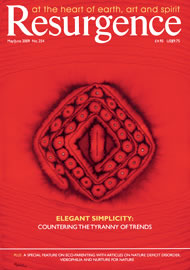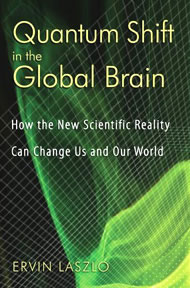WRITTEN BEFORE THE full force of the financial and economic storm hit us, this book assumes even greater relevance for Resurgence readers trying to understand the underlying dynamics of our situation and see beyond the ‘business as usual’ perspective. Newspaper pundits are displaying more humility than a year ago, and now admit that they don’t know how it will all end. They struggle to understand the current crisis in terms of previous crises such as occurred in 1929, 1987 or the early 1990s. However, we also need to assess the extent to which the current crisis is unprecedented. Population pressure was far less intense, and natural resources far more abundant eighty years ago than now.
In a series of books published over the last ten years, Ervin László has refined and extended his understanding of our predicament. In this book, he examines the possibility of what he calls a “quantum shift in the global brain”, defining the global brain as the “quasi energy- and information-processing network created by six-and-a-half billion humans on the planet” interacting on many levels. A quantum shift in the global brain is a “sudden and fundamental transformation in the relations of a significant segment of the six-and-a-half billion humans to each other and to Nature”– what he calls a “macroshift”, not only in society but also in our understanding of the nature of reality through a paradigm shift in science. It is these two shifts together that constitute what he calls a “reality revolution”.
The book is divided into three parts: the first describes macroshift in society, the second looks at paradigm shift in science, and the third explains the ways in which the Club of Budapest is initiating “globalshift”. This gives the reader both a theoretical and a practical understanding of our situation and its possibilities. The question we are facing is one of evolution or extinction. ‘Business as usual’ is inherently unsustainable and is likely to lead to increasing instability and breakdown in all spheres of human activity – social, financial, economic, political and ecological. However, another scenario describes timely transformation in which we create a sustainable and co-operative world.
We all recognise that global problems demand global solutions, but there lurks a danger that the solutions will be imposed from above rather than evolving from below. It is increasingly apparent that we have reached a bifurcation point in which the elements of breakdown can potentially be transmuted into the components of a breakthrough. László explains this in terms of five phases of the macroshift, namely trigger, transformation, critical or chaos, breakdown, and breakthrough. Needless to say this is an uncomfortable process, but the roots of unsustainability make it almost inevitable.
Reflecting on our current modality of extensive growth based on conquest, colonisation and consumption, László analyses nine outdated beliefs and six dangerous myths (for example, Nature is inexhaustible and is like a giant mechanism) before suggesting ten new commandments of a timely vision and the path towards a planetary ethic. These values and perceptions will be familiar and congenial to Resurgence readers, who will also appreciate
László’s maximum code of acting so as to maximise the sustained persistence of the biosphere, and minimum code of living so that others can also live. This reflects the emergence of a new culture of ‘Holos’, corresponding to the worldview of the ‘cultural creatives’.
Significantly, both spiritual and scientific perspectives are coming together in a new vision of wholeness involving the cosmic plenum, nonlocality and coherence. The old picture of isolated atoms and particles is now being replaced by a more integrated and interconnected view, which intrinsically includes the nature of human consciousness. Here, László proposes a new theory of the Akashic Field incorporating the totality of information and consciousness. In an intriguing annex, he extends this theory to discarnate communication, which he has experienced at first hand. He is reluctant to envisage the idea of surviving soul, but rather proposes that our memories live on as an autonomous hologram leaving a trace in the plenum. This is a more sophisticated version of the ‘psychic soup’ hypothesis, but I don’t think it successfully accounts for real interactions between the incarnate and the discarnate, which imply continued development of consciousness. The overall message of the book, however unlikely this seems at present, is that humanity is a system capable of rapid transformation. We will soon enough discover whether this is true. •
David Lorimer is Programme Director of The Scientific and Medical Network.







